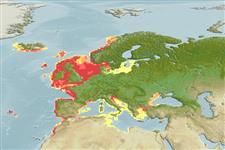Common names from other countries
Classification / Names / Names
Namen | Synonyme | Catalog of Fishes (gen., sp.) | ITIS | CoL | WoRMS
Environment: milieu / climate zone / depth range / distribution range
Ökologie
; tiefenbereich 0 - 150 m (Ref. 4), usually ? - 50 m (Ref. 4). Subtropical, preferred 12°C (Ref. 107945); 69°N - 29°N, 28°W - 32°E (Ref. 4)
Eastern Atlantic, Mediterranean and Black Sea. Not in east of Crete and in the Baltic Sea.
Length at first maturity / Size / Gewicht / Alter
Maturity: Lm 8.9, range 8 - 8.3 cm Max length : 65.0 cm TL Männchen/unbestimmt; (Ref. 441); common length : 40.0 cm TL Männchen/unbestimmt; (Ref. 441); max. veröff. Gewicht: 6.0 kg (Ref. 4); max. veröff. Alter: 72 Jahre (Ref. 81081)
Common total length: 23 to 50 cm.
Females with eggs are usually found throughout the year. The eggs are laid around July and carried for 10 to 11 months (Ref. 4). Coupling occurs a few days after the female molts (Ref. 80921).
Holthuis, L.B. 1991. (Ref. 4)
IUCN Rote Liste Status (Ref. 130435: Version 2024-1)
CITES Status (Ref. 108899)
Not Evaluated
Not Evaluated
Nutzung durch Menschen
Fischereien: hoch kommerziell; Aquakultur: experimental
FAO - Fischereien: landings, Artbeschreibung | FishSource | Sea Around Us
Tools
Internet Quellen
Estimates based on models
Preferred temperature
(Ref.
115969): 7.7 - 13.3, mean 10.4 (based on 494 cells).
Widerstandsfähigkeit
hoch, Verdopplung der Population dauert weniger als 15 Monate. (K=0.79-1.0; Fec=13,000).
Prior r = 0.37, 95% CL = 0.25 - 0.56, Based on 1 data-limited stock assessment.
Verwundbarkeit
Moderate to high vulnerability (53 of 100).
